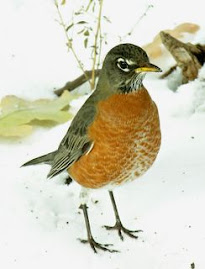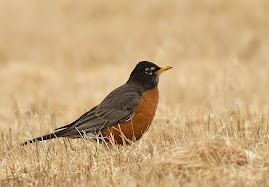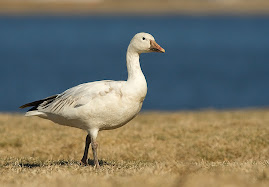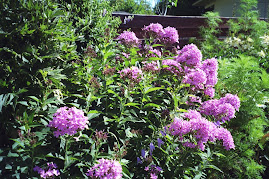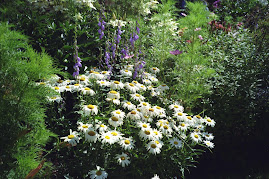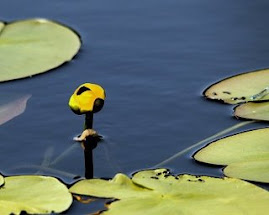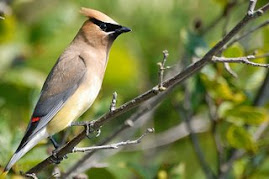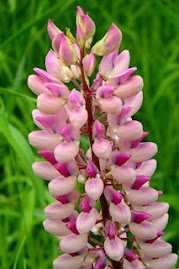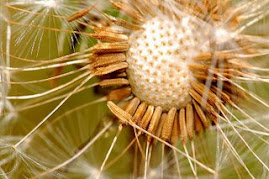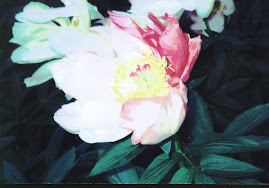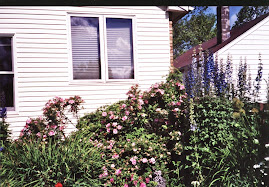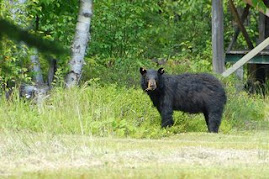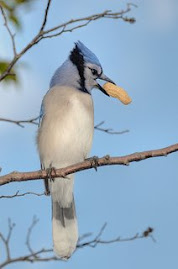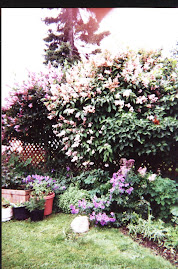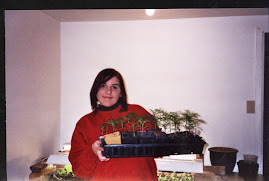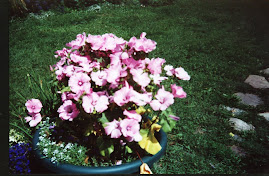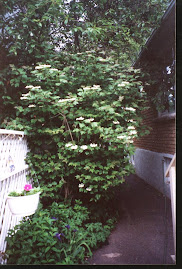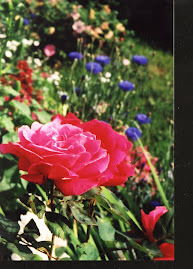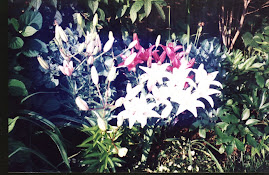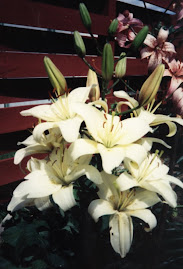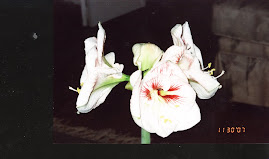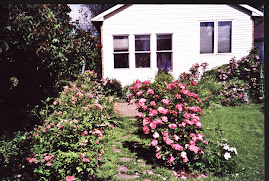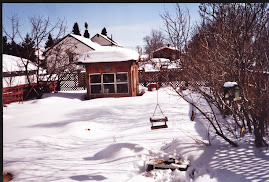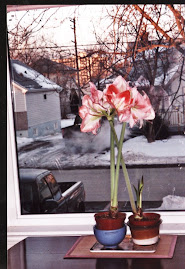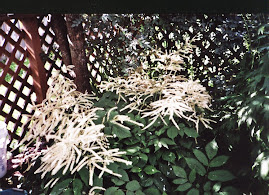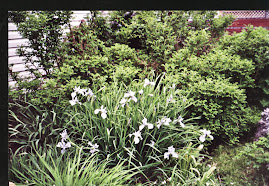Last Thursday night, after a family dinner, I said good-bye to the garden. I walked around in the dark zero degree air and said good-bye to the big hosas, the cosmos, the lavatera, and the nicotania. The next morning I saw a half frosted garden.
It was interesting to note what survived and what lived. The plants close to the fence and the shed fared better than those exposed in the centre bed. The front yard was not touched at all nor was the side garden between two houses. But an area in the back a slight bit lower that the main section was badly hit. Usually the hostas are most susceptible to frost but this year it was the cosmos.
Today I pulled out black cosmos. They were the biggest and toughest cosmos I have ever grown. Many plants were over 6 feet tall with stalks like small trees. I also continued weeding and emptying pots. I empty pots the easy way by pulling out the plants and then tipping the pot into the garden and spreading the soil among the perennials. This is easier than shovelling into a wheel barrow etc.
Showing posts with label Frost. Show all posts
Showing posts with label Frost. Show all posts
Monday, 6 October 2008
Friday, 30 May 2008
WHAT A WEEK
Two nights of below zero, two evenings covering my annuals, two dawn forays to water away the frost and then, the reward--two fabulous days of paradise. Only the geraniums and one begonia were badly frost damaged. They are alive but addled looking.
This is the time of year for plant sales. I dropped into the Labour Centre last Tuesday to check out the sale for the Arthritis Society. The usual perennial customers were there, the splits off the hardy plants of the city. If I were starting a perennial bed, I’d start with this kind of sale.
Ice cream pails held chunks of the golden orange day lily which nothing can kill. The dark purple bearded iris sat next to a row of goat’s beard, a great find for a new gardener. Pots of the world’s hardiest hosta, a green with white edges, took up one end of a table. Fifteen minutes after the doors opened, the stock was going fast. I was delighted to scoop up four columbine plants at 2$ each and a big shasta daisy for 6 bucks. These plants replace my winter losses. I was tempted by the lamium, a variegated creeping plant that makes great edges and the Virginia creeper.
Meanwhile in the garden. I’ve planted all the annuals. I’ve swept out the garden shed and hosed down the plastic trays and containers. The squash, zucchini and cucumber plants are sitting in the sun, ready to be planted after I arrange the weed barrier over the small area I call a vegetable garden. Nothing to do but get a book and a cup of tea and watch the birds. What a week!
TIP: check the yard sales listing in the newspaper for plant sales this weekend.
This is the time of year for plant sales. I dropped into the Labour Centre last Tuesday to check out the sale for the Arthritis Society. The usual perennial customers were there, the splits off the hardy plants of the city. If I were starting a perennial bed, I’d start with this kind of sale.
Ice cream pails held chunks of the golden orange day lily which nothing can kill. The dark purple bearded iris sat next to a row of goat’s beard, a great find for a new gardener. Pots of the world’s hardiest hosta, a green with white edges, took up one end of a table. Fifteen minutes after the doors opened, the stock was going fast. I was delighted to scoop up four columbine plants at 2$ each and a big shasta daisy for 6 bucks. These plants replace my winter losses. I was tempted by the lamium, a variegated creeping plant that makes great edges and the Virginia creeper.
Meanwhile in the garden. I’ve planted all the annuals. I’ve swept out the garden shed and hosed down the plastic trays and containers. The squash, zucchini and cucumber plants are sitting in the sun, ready to be planted after I arrange the weed barrier over the small area I call a vegetable garden. Nothing to do but get a book and a cup of tea and watch the birds. What a week!
TIP: check the yard sales listing in the newspaper for plant sales this weekend.
Tuesday, 27 May 2008
Fighting the Freeze
Ice coated the birdbaths at 6 this morning when I got up to see how my planted annuals fared in the below-freezing temperatures. After gardening at this address for nineteen years, I know which areas are most susceptible to frost and which areas ride it out. I know the front yard is the warmest and the north west corner of the back yard the coldest. Even one degree can make a difference. Usually the highest elevations are warmer than lower. So I started spraying water on the plants in the vulnerable areas. I removed the pots, pans and even two waste paper baskets I had put over the bigger plants. I pulled off the space blankets (survival blankets) that I had spread around last night using rocks, tools and any damn thing to hold them flat from the wind. I took a break and came out and sprayed the flower beds again, this time doing the front garden as well. Later, just after sun rise, I sprayed again.
The results. All the annuals that were covered survived well, even the geraniums. Plants with big flat leaves like geraniums are the most susceptible to frost so I'd been worried about them. The begonias which were covered with the wastepaper baskets did better than the one that got no covering at all. It will lose a few leaves, I'm afraid, but it will survive.
Some people cover with old bed sheets and this works well. Many years ago, when I lived in Kaministiquia, we covered vegetables with clear plastic but I would not recommend this practice. A bright dawn sun can burn the leaves through the plastic. Besides, plastic sheeting is awkward and heavy and flattens plants. A few years ago, I had a stroke of luck, a sale at Canada Tire of space blankets for a buck each. I bought ten. They have served me well. I also have an old row cover or frost cover and it protected the nicotania on the northwest corner. Plants by a house will survive a frost better than those in the open garden. So, new gardeners, I suggest you watch carefully in the fall to see where the frost hits first. This knowledge could save your garden.
The results. All the annuals that were covered survived well, even the geraniums. Plants with big flat leaves like geraniums are the most susceptible to frost so I'd been worried about them. The begonias which were covered with the wastepaper baskets did better than the one that got no covering at all. It will lose a few leaves, I'm afraid, but it will survive.
Some people cover with old bed sheets and this works well. Many years ago, when I lived in Kaministiquia, we covered vegetables with clear plastic but I would not recommend this practice. A bright dawn sun can burn the leaves through the plastic. Besides, plastic sheeting is awkward and heavy and flattens plants. A few years ago, I had a stroke of luck, a sale at Canada Tire of space blankets for a buck each. I bought ten. They have served me well. I also have an old row cover or frost cover and it protected the nicotania on the northwest corner. Plants by a house will survive a frost better than those in the open garden. So, new gardeners, I suggest you watch carefully in the fall to see where the frost hits first. This knowledge could save your garden.
Monday, 26 May 2008
THE MERCURY IN THE THERMOMETER”S SOCKS
We interrupt this discussion of cages and propping. It is cold out and supposed to get to minus 3 in the night. Emergency measures needed. I am putting a pot or cover over all the recently planted annuals. However, with this high wind, plastic flower pots may blow away. The perennials can fare for themselves. I carried all the flats of annuals into the shed and have hooked up a small heater which I will switch on at midnight. I’ll get up before dawn and water the entire garden to wash the frost off. That’s the plan and I’ll let you know the results. The sky is cloudy, a hopeful sign. When you get a clear sky and dropping temperatures, watch out.
Subscribe to:
Posts (Atom)







